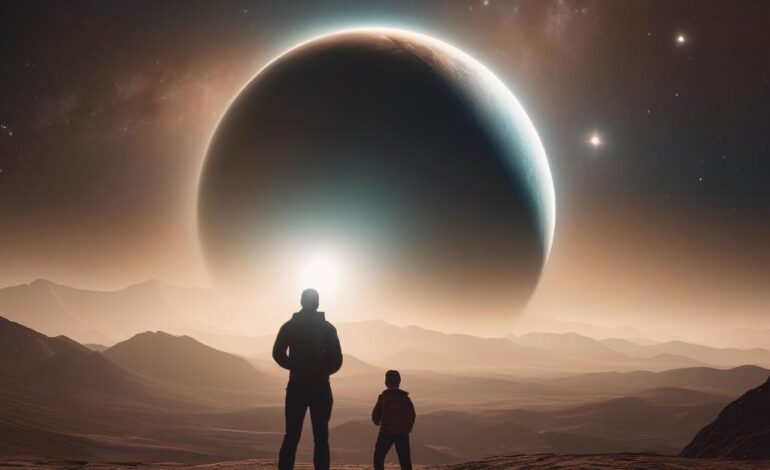How Does a Planet Differ from a Star?

-
Table of Contents
When we gaze up at the night sky, we are often captivated by the celestial bodies that adorn it. Among these objects, planets and stars stand out as the most prominent and intriguing. While both planets and stars exist in the vast expanse of the universe, they possess distinct characteristics that set them apart. In this article, we will explore the fundamental differences between planets and stars, shedding light on their composition, formation, and behavior.
1. Composition
One of the primary distinctions between planets and stars lies in their composition. Stars are primarily composed of hydrogen and helium, the two lightest elements in the universe. These elements undergo nuclear fusion in the star’s core, releasing an immense amount of energy in the form of light and heat. This fusion process is what sustains a star’s luminosity and allows it to emit radiation.
On the other hand, planets are composed of a variety of elements and compounds. While the exact composition varies depending on the planet, common elements found in planets include oxygen, carbon, nitrogen, and silicon. Planets are typically solid or gaseous bodies that do not undergo nuclear fusion. Instead, they reflect or absorb the light emitted by stars, making them visible to us from Earth.
2. Formation
The formation of planets and stars also differs significantly. Stars are born from vast clouds of gas and dust known as nebulae. These nebulae are composed of various elements and molecules, which gradually collapse under the influence of gravity. As the cloud collapses, it forms a dense core called a protostar. Over time, the protostar accumulates more matter and becomes a fully-fledged star, initiating nuclear fusion in its core.
Planets, on the other hand, form within the protoplanetary disks that surround young stars. These disks consist of gas, dust, and debris left over from the star’s formation. Within these disks, small particles collide and stick together, gradually growing in size. Through a process known as accretion, these particles merge to form planetesimals, which eventually coalesce to form planets. The composition and size of the protoplanetary disk influence the type of planets that can form within it.
3. Size and Mass
Size and mass are crucial factors that differentiate planets from stars. Stars are significantly larger and more massive than planets. The smallest stars, known as red dwarfs, can have a mass of about 0.08 times that of our Sun, while the largest stars, called supergiants, can have a mass over 100 times that of the Sun. In terms of size, stars can range from a few times larger than Earth to hundreds of times larger than our Sun.
On the other hand, planets are relatively small and less massive compared to stars. The size of planets can vary greatly, with some being smaller than Earth’s moon and others being several times larger than Earth. Similarly, the mass of planets can range from a fraction of Earth’s mass to several times that of Jupiter, the largest planet in our solar system.
4. Energy Source
The energy source of stars and planets is another key distinction between the two. Stars derive their energy from nuclear fusion, a process that occurs in their cores. The immense pressure and temperature at the core of a star enable hydrogen atoms to fuse together, forming helium. This fusion process releases an enormous amount of energy in the form of light and heat, which radiates outwards, making stars shine brightly.
Planets, on the other hand, do not possess an internal energy source like stars. Instead, they rely on external sources of energy, primarily from the star they orbit. Planets receive energy from their parent star in the form of sunlight, which they reflect or absorb. This energy drives various processes on the planet, such as weather patterns, climate, and the sustenance of life.
5. Behavior and Interaction
Stars and planets exhibit different behaviors and interactions within their respective systems. Stars are self-luminous and emit light and heat due to nuclear fusion. They often form the central point of a solar system, around which planets and other celestial bodies orbit. Stars also have a gravitational influence on these orbiting objects, keeping them in stable paths.
Planets, on the other hand, do not emit light of their own but reflect the light from their parent star. They orbit around stars in elliptical or nearly circular paths, influenced by the gravitational pull of the star. Additionally, planets can interact with each other gravitationally, causing perturbations in their orbits. These interactions can lead to phenomena such as planetary conjunctions and gravitational assists.
Summary
In conclusion, planets and stars differ in various aspects, including composition, formation, size, mass, energy source, and behavior. Stars are primarily composed of hydrogen and helium, undergo nuclear fusion, and emit light and heat. Planets, on the other hand, have diverse compositions, form within protoplanetary disks, and rely on external sources of energy. Stars are significantly larger and more massive than planets, and they often serve as the central point of a solar system. Planets, in contrast, orbit stars and interact with each other gravitationally. Understanding these differences enhances our knowledge of the universe and the diverse celestial objects that inhabit it.
Q&A
1. Can a planet become a star?
No, a planet cannot become a star. Stars are formed through the process of nuclear fusion, which requires immense pressure and temperature. Planets, on the other hand, do not possess the necessary conditions for nuclear fusion to occur. While planets and stars have different formation processes, they are distinct entities with their own characteristics.
2. How many planets are there in our solar system?
There are eight planets in our solar system: Mercury, Venus, Earth, Mars, Jupiter, Saturn, Uranus, and Neptune. These planets orbit the Sun and vary in size, composition, and other characteristics. Pluto, which was previously considered the ninth planet, was reclassified as a dwarf planet in 2006.
3. Are all stars the same size?
No, stars come in various sizes. The smallest stars, known as red dwarfs, can have a mass of about 0.08 times that of our Sun. On the other hand, the largest stars, called supergiants, can have a mass over 100 times that of the Sun. The size of a star is determined by its mass and other factors related to its formation and evolution.
4. Can planets exist without a star?
Planets are typically formed within protoplanetary disks that surround young stars. However, there are instances where planets can exist without a star. These planets, known as rogue planets or free-floating planets, do not orbit any star and instead drift through


